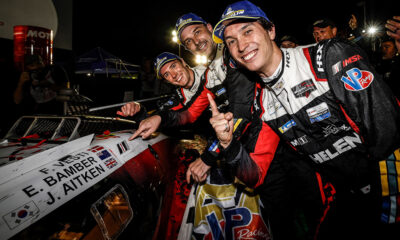
Photo: IndyCar
A mostly positive first race back in sports cars after a three-year sojourn to IndyCar provided new IMSA Race Director Beaux Barfield all he needed to know he’d made the right decision in “coming home.”
“There was not near as much stress as I’m used to,” Barfield told Sportscar365. “It was definitely fun and fulfilling. It was good to be welcomed back. It was good to get back to a place where you’re comfortable with your surroundings.”
Barfield’s first weekend back at Circuit of the Americas, officiating both the TUDOR United SportsCar Championship and Continental Tire SportsCar Challenge races, was more or less a home race as he lives two hours from Austin in Houston.
This weekend’s 2014 season finale at Road Atlanta comes at a track that he worked at for 15 years.
Barfield did not want to reinvent the wheel in his return for his first sports car race in Race Control since his ALMS Race Director days. Instead, he said, he focused on maintaining the protocol and precedent established throughout the season.
“Everything we reviewed we did with what was the precedent set this year,” he said. “I didn’t step in here to change everything. We’re winding the season down, so to change a lot of things would be inappropriate.”
Still, that didn’t mean there wasn’t swift action taken when needed. A quick yellow in the CTSC race, thrown immediately after Tim Bell’s massive first lap accident on the run to Turn 12, stood out.
“When the Tim Bell situation happened, I was already looking at a car that was stopped at Turn 1, and we were getting to the point where we had to make a call as to whether to throw the yellow,” Barfield said.
“Right at my pre-determined moment in terms of seeing where the leaders were, Tim Bell goes flying off, and as soon as we saw him go, it was just time to go (yellow). It wasn’t anything magic or special but we were prepared.”
Additionally, Barfield made his presence felt with four cars (Cars 90, 910, 54 and 23) called for Incidents in the TUDOR race. Those four cars were issued drive-through penalties for the infringements. Barfield explained the rationale that led to those decisions.
“We spent a lot of time on them,” he said. “Coming out of the system I was used to, I had to make absolute certain I had everyone on board. Were they cut and dry? No, but we spent a lot of time on it, and decided them like we would have all year.”
No further action was taken following first lap contact between the No. 10 Wayne Taylor Racing Corvette DP and No. 42 OAK Racing Ligier JS P2 Honda, and additionally with the contact later in the race between the No. 81 GB Autosport Porsche 911 GT America and No. 300 Turner Motorsport BMW Z4 GT3.
Barfield’s presence as a part of the new IMSA officiating structure will likely be further felt over the offseason.
A thorough analysis and rewriting of the IMSA rulebook and in particular, a desire to cut down on yellow flag time across the board, are goals Barfield has outlined for the months in-between Petit Le Mans powered by Mazda this weekend and the 2015 season-opening Rolex 24 at Daytona.
“It’s going to be a major project,” he said. “That’s not to communicate that in a way that means everything is going to change, or will be completely revamped. But we have to streamline and simplify, and those are definitely missions as we go through the offseason to rewrite the book.”
For the yellows, of which length has been a concern this season, Barfield wants to strike a balance between allowing the four-class racing to play out while still reducing the time.
“Coming in, I read a lot of comments, and a lot of frustration, from teams or fans about the length of yellows,” Barfield explained. “From my time in sports car racing, there was a lot I contributed to make those yellows longer to keep the class races intact.
“There’s a delicate balance we always have to find between keeping them intact but not make the yellows too long.
“The point for me was to be very sensitive to the negativity, frankly, surrounding the longer yellows. It was high on my list of things to accomplish, trying to shorten them or limit them altogether.”
Barfield said there were a lot of familiar faces from his time in ALMS he can get reacquainted with, but also mentioned the importance of getting to know the new faces and understand the paddock’s temperament.
Coming from IndyCar, and realizing the scope of putting together two entirely disparate series and philosophies, Barfield described his view of the paddock as an outsider.
“A lot of people underestimate what an incredible undertaking that’s been,” he said. “There were a lot of positives on both sides that basically fell by the wayside due to attrition and available energy. It wasn’t intentional.
“With this restructuring, with Simon Hodgson coming on board, I see it as nothing as a positive in terms of putting the right people in the right places.
“We need to bring back the positives for our competitors and fans; they need to appreciate what we put out, and help us make this thing huge in the future.”





















